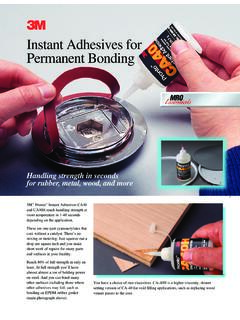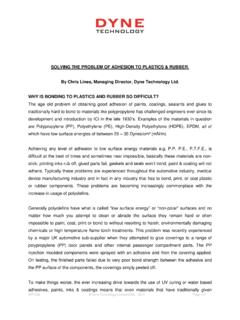Transcription of Non-Destructive Inspection of Adhesive Bonds in Metal ...
1 2009 DOE Vehicle Technologies Program Review - ALMNon- destructive Inspection of Adhesive Bonds in Metal - Metal Joints Launched Aug. 2006 David Moore, co-PIsDennis RoachCiji NelsonSandia National Laboratories21 May 2009 This presentation does not contain any proprietary, confidential, or otherwise restricted informationProject ID: lm_15_mooreOutline NDE601 Objectives FY09 Milestones Technical Barriers Approach Performance Measures and Accomplishments Technology Transfer Publications/Patents Plans for Final Year SummaryNDE Objectives Develop nondestructive Inspection (NDI) methods for Adhesive bond evaluation that can be used in an automotive manufacturing environment to foster increased confidence and use of Adhesive joining.
2 Impetus: The wider use of Adhesive joining will result in reduced vehicle weight, increased body stiffness, and improved crashworthiness. Adhesives are also a critical enabler for the joining of dissimilar materials. Apply NDI methods to characterize weak Bonds and quantify their strengthsTo accomplish the above objectives, the various attributes that determine the bond strength must be identified. A nondestructive Inspection method must developed to assure the strength of the Adhesive . The success of this approach will be quantitative correlations of NDI to measured bond strengths for full strength Bonds and weak Barriers Adhesives increasingly being used because they Increase body stiffness - without significant mass increase Increase body strength without significant mass increase Enable dissimilar materials, steel + Mg, or composite + steel to be used next to each other Reduce cost of light-weight materials.
3 Adhesive bonding is a critical technology Present in 95% of the Mg Front End joints Present in all the Composite Underbody joints Allows less expensive sheet product to be used instead of castings or extrusions Spread strain for more brittle light-weight materials, especially around Milestones Milestone 1: Complete Finalize the ultrasonic signal processing capabilities within the Ultrasonic Phased-Array system and determine if an Adhesive thickness algorithm can be applied to the USCAR production Inspection equipment. Milestone 2: CompleteFinalize and deploy an ultrasonic Inspection system at one of the USCAR production plants.
4 Develop a written procedure and provide initial training to Inspection personnel. Milestone 3: OngoingManufacture the weak bond samples and evaluate a wide array of candidate NDI methods. Down-select a nondestructive Inspection technique that can accurately detect/assess kissing or weak Bonds . (Final Tasks 10 15 of the project)Approach Work with Adhesive suppliers to identify key features that determine the Adhesive bond strength quantitatively (complete) Work with NDT experts, especially from aerospace, to identify leading NDT technologies to measure these properties in vehicle structures (complete) Verify targeted methods on coupons (NDT prediction vs.)
5 Quantitative strength measurements) Test performance of methods on production vehicle bodies PartnersApproach - Mapped to Production Requirements The method(s) must be single-side inspections that can follow a flange, navigate large changes in geometry, have spatial resolution near 1-mm and have an overall Inspection speed of at least 1 m/min. The Inspection method(s) must be deployed on multiple automotive bodies in white (BIW) containing Adhesive joints produced by the OEMs. Complex geometries can impede the Inspection two-step validation process has been followed: first successfully inspect the flat engineered adhesively bonded specimens, representative of automobile flanges.
6 Secondly, deploy the Inspection method on production car Mechanical Strength Characterization of Adhesive Joints The wedge-peel method uses an instrumented load frame to pull a standard wedge (IS011343) through the Adhesive bond . This creates a high-resolution strength map (shown at right). The load frame versus displacement curve was compared with NDE Inspection data. Simple Adhesive strength laws based on bond width and thickness are adequate for predicting the wedge peel strength if the bond strength varies over multi-centimeter length scales. Accomplishments Deployed a high-frequency ultrasonic phased array probe Manual Portable closed loop waterCOTS Water use: <1 cup/100 m Resolution: mm Speed.
7 5 m/minMechanicalscanAccomplishments Deployed a 2ndgeneration high-frequency ultrasonic phased array probe Can inspect 85% of footprint Can inspect more confined locations Can inspect virtually any convex surface Can inspect panels with tight concave curvature ( m radius)MechanicalscanGen 1 Gen 2 Encoder typewheelstringBody width37 mm18 mmScan width25 mm15 mmHeight50 mm25 mmLength90 mm65 mm Team completed the evaluation of the first generation array and probe holder on three body-in-white (BIW) structures BIW inspections covered 100 beads with a wide variety of geometries and probe orientations Over 80 % of the Adhesive structure could be imaged at a speed of over 1 m/min Images showed large-scale features such as Adhesive spread and the fill-factor of the flange.
8 The 1-mm resolution also allows small features such as surface springback, air entrainment; beads dribbles, and weld expulsion damage to be Body in White Inspections3 Bodies at Sandia/FAA NDI Validation CenterAccomplishments Body in White Inspections Floor PanelsNo SealantEdge of PartNo SealantSealantEdge of PartAccomplishments- Weak ( Kissing ) bond Detection Carefully controlled lap-shear coupons were produced with repeatable amounts of contamination. Extensive work was completed on Bonds that have intimate contacts but are weak: so-called kissing Bonds .
9 Several new contaminates, were shown to reproducibly reduce bond strength. It was shown that grease reduces both shear and tensile strength with the same sensitivity dependence and that grease contamination can be detected with ultrasonic pulse/echo Inspection . Accomplishments- Weak ( Kissing ) bond Detection Reliable methods developed to produce desired range of weak Bonds : 10%, 30%, 50%, 70% 90%, 100%; critical to NDI studies; involved use of controlled application of contaminants and Adhesive reactants A large suite of coupons with reduced bond strengths were built for round robin testing of advanced Inspection methods.
10 NDI being applied includes: Through-Transmission Ultrasonics (TTU), Pulse-Echo UT, Phased Array UT, Thermography, Laser Shot Peening, Nonlinear UT, UT Spectroscopy, Resonance, Air-Coupled UT, Modal Analysis, Laser UT Accomplishments- Weak ( Kissing ) bond DetectionT-PWD-100-13F-ET-GRE-100-05-15F -ET-PWD-25-15F-ET-GRE-100-02-15F-ET-PWD- 10-15F-E30%30%10%10%50%T-SC-25-11F-ET-MO -RE-MS-50-12F-ET-GRE-100-01-15F-ET-MO-RE -MS-25-11F-ET-PRI-11F-E70%50%90%70%100% bond StrengthStronger BondsThrough-Transmission Ultrasonics traces bond strengthBond RegionAccomplishments- Weak ( Kissing )



















